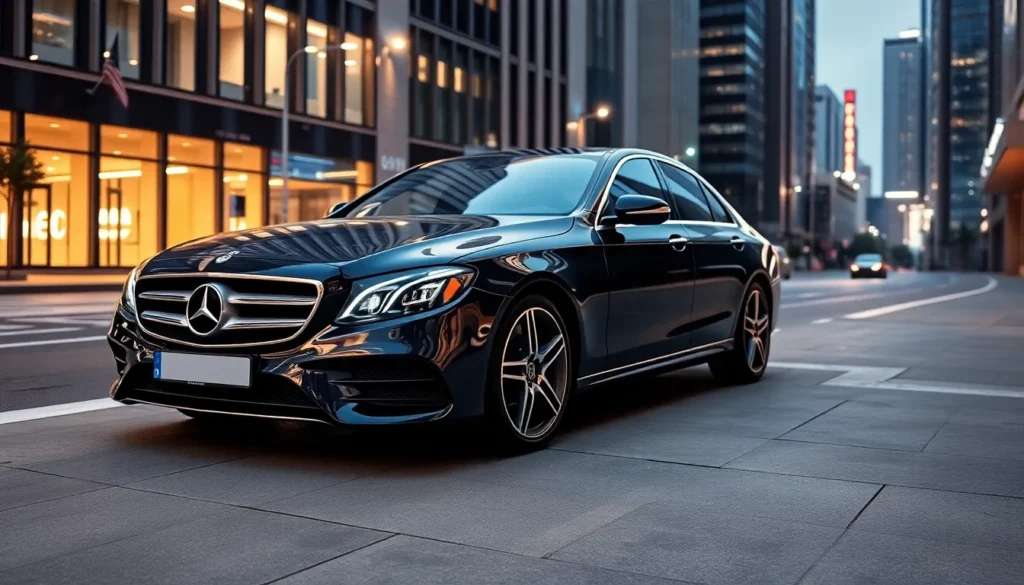We’ve all felt that undeniable pull when a Mercedes-Benz glides past – there’s something magnetic about the way these vehicles command attention without trying too hard. The Mercedes-Benz aesthetic isn’t just about luxury; it’s a carefully crafted design philosophy that’s evolved over decades to represent sophistication, performance, and timeless elegance.
From the iconic three-pointed star that crowns every grille to the flowing lines that define each silhouette, Mercedes-Benz has mastered the art of creating vehicles that look as exceptional as they perform. We’re talking about a brand that’s consistently pushed the boundaries of automotive design while maintaining that unmistakable DNA that makes every model instantly recognizable.
Understanding the Mercedes-Benz aesthetic means diving into a industry where every curve serves a purpose and every detail tells a story of German engineering excellence.
The Evolution of Mercedes-Benz Design Philosophy
Mercedes-Benz design philosophy has transformed dramatically since the brand’s inception, evolving from purely functional engineering to a sophisticated blend of luxury aesthetics and cutting-edge innovation. We examine two distinct eras that shaped the iconic mercedes benz aesthetic into what captivates enthusiasts today.
Classic Era: Timeless Elegance and Functionality
Classic Mercedes-Benz vehicles from the 1950s through 1980s established the foundation of timeless automotive design. Engineers prioritized function over form during this period, creating vehicles with clean geometric lines and purposeful proportions. Chrome accents adorned the exterior surfaces while leather interiors featured minimalist layouts focused on driver ergonomics.
Notable models like the 1954 300SL Gullwing demonstrated how Mercedes-Benz aesthetic elements could emerge from engineering necessity. The distinctive upward-opening doors weren’t just stylistic choices but answers to structural challenges posed by the space frame chassis. Similarly, the iconic grille design evolved from cooling requirements into a brand signature that we recognize across all model lines today.
Quality materials defined the classic era approach to luxury. Manufacturers selected wood veneers based on grain patterns and durability rather than trends. Metal components received multiple finishing processes to ensure longevity. Interior layouts emphasized functionality with analog gauges positioned for optimal visibility and controls placed within natural reach zones.
Modern Era: Contemporary Luxury and Innovation
Modern Mercedes-Benz design philosophy embraces digital integration and aerodynamic efficiency while preserving brand heritage elements. Designers now use computer-aided modeling to create flowing surfaces that reduce wind resistance by up to 15% compared to previous generations. LED lighting systems allow for distinctive signatures that enhance brand recognition while consuming 60% less energy than traditional halogen systems.
Contemporary mercedes benz aesthetic incorporates sustainable materials without compromising luxury standards. Recycled plastics appear in interior trim pieces while renewable wood sources maintain the premium feel classic models established. Advanced manufacturing techniques enable more complex surface treatments and precision assembly tolerances measured in fractions of millimeters.
Technology integration shapes modern design decisions across all vehicle categories. Touch-sensitive controls replace mechanical switches while maintaining the tactile feedback luxury customers expect. Digital displays can show multiple information layouts while preserving the clean dashboard aesthetics that define Mercedes-Benz interiors. Voice control systems respond to natural language commands while speakers remain discretely integrated into cabin surfaces.
Exterior Design Elements That Define Mercedes-Benz Aesthetic
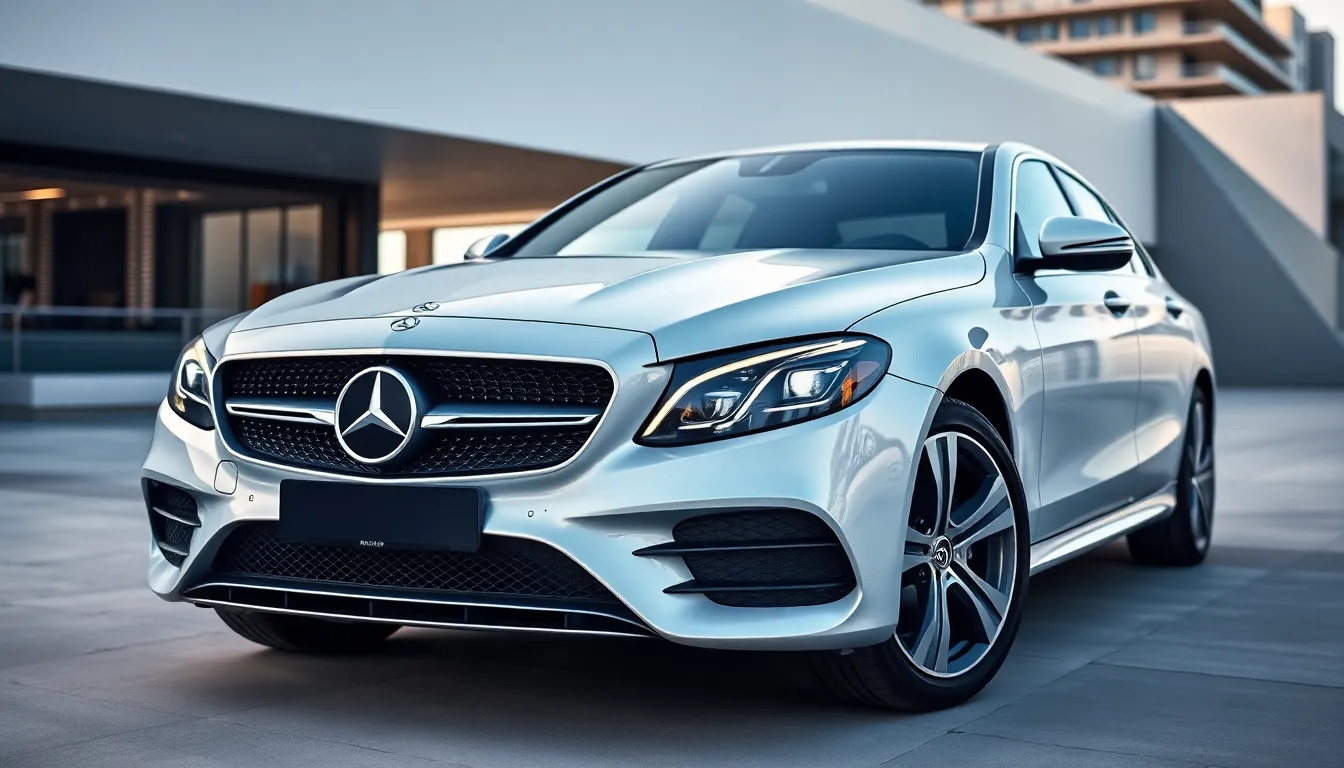
Mercedes-Benz exterior design elements create an unmistakable visual identity that distinguishes these vehicles across global markets. Each component works harmoniously to establish the brand’s sophisticated aesthetic language.
The Iconic Three-Pointed Star and Grille Design
The three-pointed star emblem represents Mercedes-Benz’s original vision of universal motorization across land, sea, and air applications. Positioned prominently on the front grille, this symbol measures approximately 90mm in diameter on most passenger vehicles and serves as the focal point of the brand’s face.
Modern Mercedes-Benz grilles feature distinctive patterns that vary across model lines. AMG variants incorporate vertical chrome slats with diamond-pattern inserts, while luxury-focused models display horizontal chrome bars with subtle geometric detailing. The grille dimensions typically span 600-800mm in width, creating substantial visual presence.
Chrome surrounds frame the grille structure on premium models, extending into the headlight housings to create visual continuity. Black piano finish accents replace chrome on sport-oriented variants, delivering a more aggressive appearance that appeals to performance-focused buyers.
Sleek Body Lines and Proportions
Mercedes-Benz body proportions follow exact ratios that create visual harmony across different vehicle segments. The brand employs a 60:40 cabin-to-hood proportion on sedan models, establishing an elegant stance that emphasizes both luxury and athleticism.
Character lines flow from the front wheel arches to the rear taillights, creating unbroken visual paths that enhance aerodynamic perception. These lines typically sit 850-950mm above ground level, positioning them at optimal viewing angles for pedestrian observers.
Wheel arch flares integrate seamlessly with body panels, accommodating wheel sizes ranging from 17 inches on entry models to 22 inches on high-performance AMG variants. The flush integration eliminates visual disruption while maintaining the clean surface language that defines Mercedes-Benz aesthetic appeal.
Door handles on contemporary models feature frameless designs that sit flush with body panels when not in use. This detail contributes to the smooth surface treatment while reducing aerodynamic drag by approximately 2-3% compared to traditional protruding handles.
Signature Lighting Features
Mercedes-Benz lighting design incorporates distinctive LED signatures that create instant brand recognition during both daytime and nighttime conditions. Headlight units feature C-shaped daytime running lights that mirror the brand’s logo curvature, establishing visual consistency across the model range.
Multibeam LED technology delivers up to 84 individually controlled light sources per headlight assembly, providing precise illumination patterns that adapt to driving conditions. These systems produce 1,300 lumens of light output while consuming 40% less energy than traditional halogen alternatives.
Taillights employ OLED technology on premium models, creating segmented light patterns that animate during vehicle startup sequences. The distinctive three-segment design references the brand’s three-pointed star, reinforcing brand identity through subtle design cues.
Interior ambient lighting extends the signature lighting experience into the cabin, offering 64 different color combinations that synchronize with exterior lighting themes. This integration creates a cohesive lighting network that enhances the overall Mercedes-Benz aesthetic experience.
Interior Craftsmanship and Luxury Details
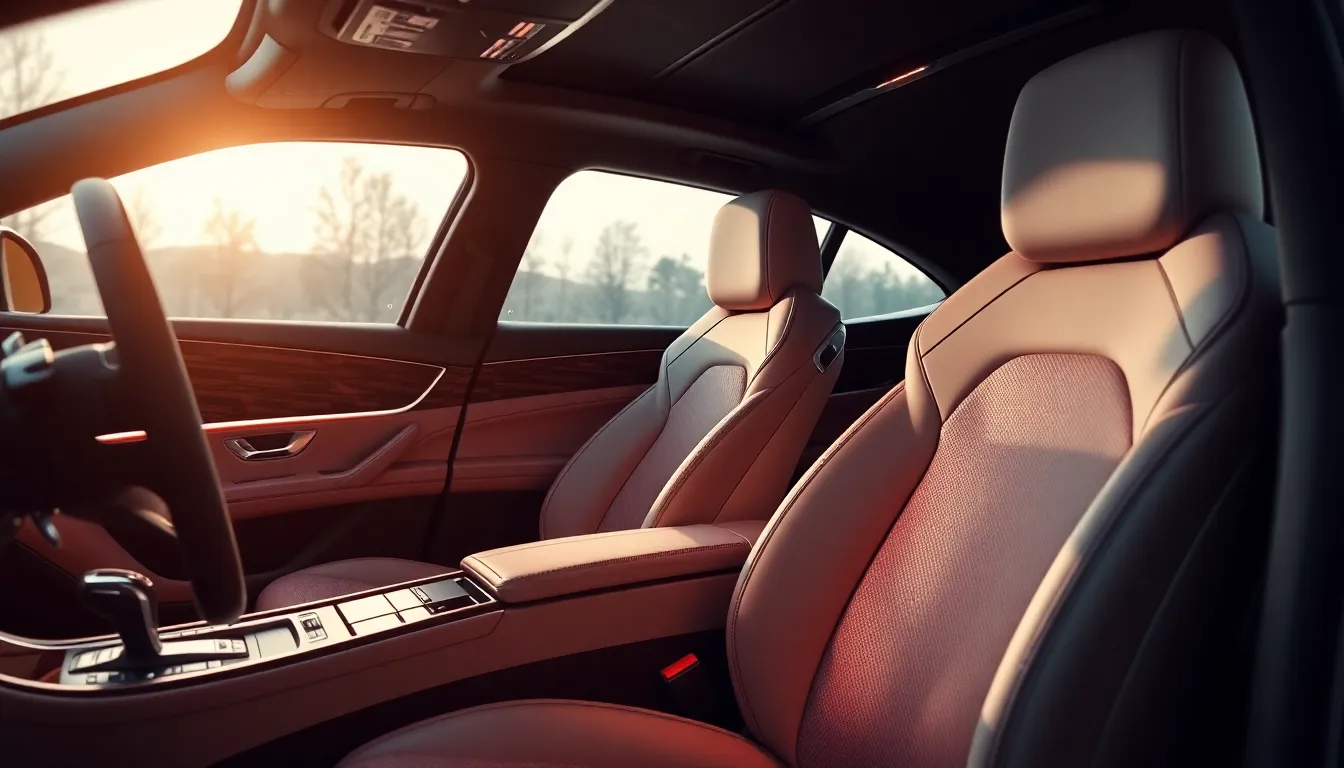
Mercedes-Benz interior craftsmanship transforms automotive spaces into luxury sanctuaries through meticulous attention to detail and premium materials. Each cabin element reinforces the brand’s commitment to sophisticated aesthetics that extend beyond the striking exterior design.
Premium Materials and Finishes
Nappa leather upholstery defines the tactile experience across Mercedes-Benz interiors, offering buttery softness and durability that ages gracefully. We find genuine wood trim options including open-pore walnut, high-gloss burl walnut, and dark ash wood that create warm contrast against metallic accents.
Aluminum trim pieces feature brushed or piano black finishes that complement the overall aesthetic theme. Carbon fiber elements appear in AMG variants, providing motorsport-inspired textures that enhance performance credibility. Hand-finished stitching patterns create visual interest on dashboard surfaces, door panels, and seat bolsters using contrasting thread colors.
Crystal elements from Swarovski adorn select models, appearing in speaker surrounds and interior accents that catch ambient lighting. These materials undergo rigorous testing including UV exposure simulation, temperature cycling, and wear resistance evaluations to maintain their appearance over time.
Ergonomic Design and Technology Integration
MBUX infotainment system integrates seamlessly into dashboard architecture through floating displays that appear to emerge from wood or metal trim surfaces. Touch-sensitive controls replace traditional buttons across climate and audio functions, creating clean interior lines that mirror exterior design principles.
We observe strategic placement of 64-color ambient lighting strips that follow natural hand movements and sight lines throughout the cabin. These lighting zones include door handles, cup holders, air vents, and footwell areas that create a cohesive illumination experience.
Seat adjustment controls feature intuitive positioning on door panels, allowing fingertip access without disrupting driving posture. Mercedes-Benz positions frequently used functions within the primary control zone, reducing driver distraction while maintaining sophisticated appearance standards.
Wireless charging pads integrate flush with center console surfaces, eliminating cable clutter while maintaining clean aesthetic lines. USB-C ports appear in discrete locations that preserve interior design integrity without compromising functionality for modern device connectivity needs.
Mercedes-Benz Model Lines and Their Distinct Visual Identity
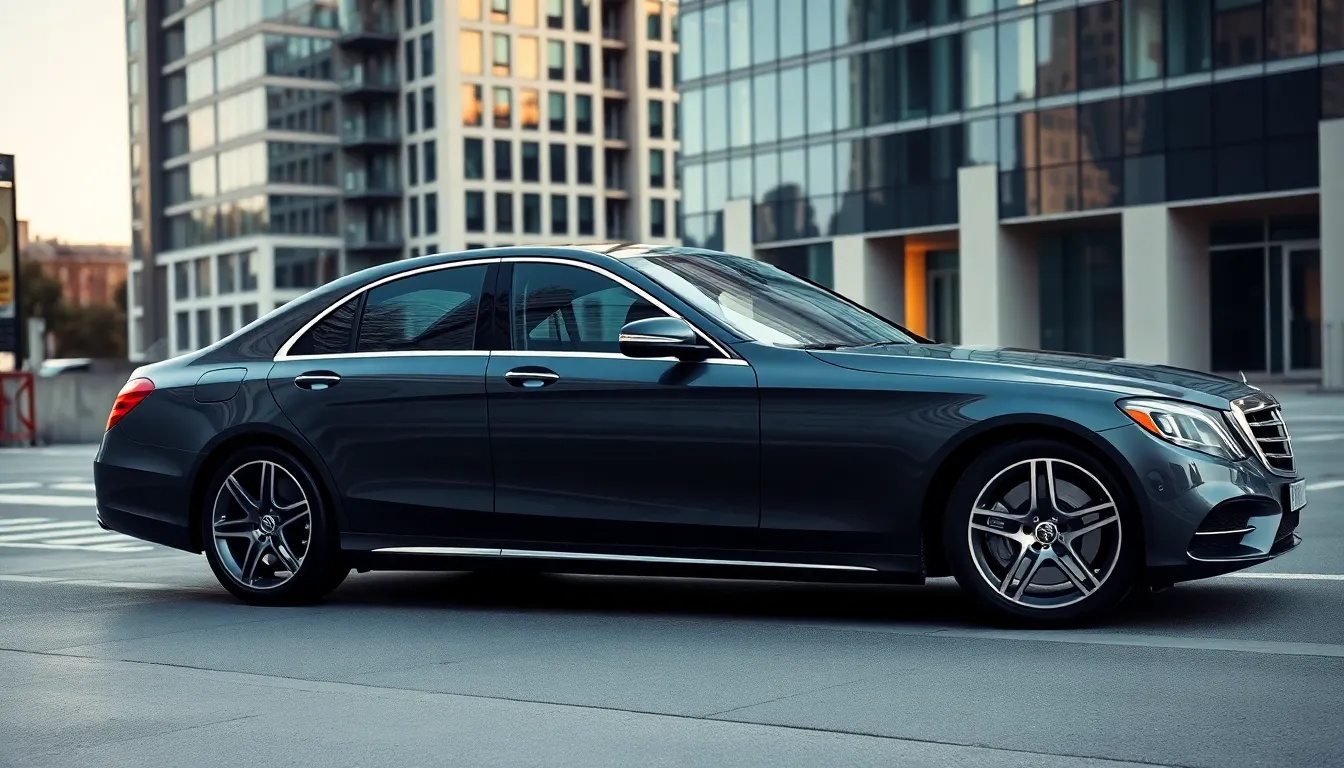
Each Mercedes-Benz model line embodies a exact aesthetic philosophy that caters to distinct consumer preferences. These visual identities showcase the brand’s versatility while maintaining core design principles.
S-Class: Ultimate Luxury and Sophistication
The S-Class represents the pinnacle of Mercedes-Benz luxury design with its commanding presence and refined proportions. Chrome accents flow seamlessly across the body, creating elegant transitions between surfaces that emphasize the vehicle’s premium positioning. Large wheel arches accommodate 19-inch to 21-inch alloy wheels that enhance the stately appearance.
Interior spaces feature hand-selected leather surfaces in 15 available color combinations, paired with open-pore wood veneers sourced from sustainable forests. Executive rear seating configurations include massage functions with 10 different programs, while ambient lighting systems offer 64 color options throughout the cabin. Crystal-clear glass applications, including door handles and air vents, elevate tactile experiences beyond traditional automotive standards.
| S-Class Luxury Features | Specifications |
|---|---|
| Leather Color Options | 15 combinations |
| Ambient Lighting Colors | 64 options |
| Massage Programs | 10 different types |
| Wheel Sizes | 19-21 inches |
| Wood Veneer Types | 4 sustainable options |
AMG Performance Models: Aggressive Sportiness
AMG models transform the Mercedes-Benz aesthetic through bold visual statements that communicate performance capabilities. Panamericana grilles feature vertical chrome slats that create distinctive front fascia designs, while wider fender flares accommodate larger brake systems and performance tires. Carbon fiber elements replace traditional chrome trim, reducing visual weight while adding technical sophistication.
Performance exhaust systems with quad tailpipes create symmetrical rear compositions that emphasize power output. Sport seats with Alcantara inserts provide enhanced grip during ever-changing driving, while red contrast stitching reinforces the performance-oriented interior theme. Digital instrument clusters display AMG-exact graphics with lap timers and g-force measurements.
Racing-inspired steering wheels feature flat-bottom designs with integrated drive mode selectors, allowing drivers to adjust suspension settings and throttle response through tactile controls. Yellow brake calipers visible through spoke wheels serve as performance indicators that distinguish AMG variants from standard models.
Electric EQS Line: Futuristic Minimalism
The EQS line introduces a revolutionary design language that prioritizes aerodynamic efficiency over traditional luxury cues. Smooth body surfaces eliminate unnecessary design elements, achieving a drag coefficient of 0.20 cd that enhances electric range performance. LED light strips replace conventional headlight configurations, creating continuous illumination signatures that span the entire vehicle width.
Interior layouts feature the MBUX Hyperscreen system, a 56-inch curved display that spans from driver to passenger positions. Sustainable materials including recycled ocean plastics and vegan leather alternatives replace traditional luxury components, aligning with environmental consciousness. Rose gold accents throughout the cabin create warm contrasts against the predominantly black and white color palette.
Flush door handles retract automatically when the vehicle is locked, maintaining clean side profiles that reduce air turbulence. Glass roof panels extend across 83% of the cabin area, creating spacious interior atmospheres while maximizing natural light entry. Silent operation enhances the serene cabin environment, allowing occupants to focus on premium audio systems and ambient lighting effects.
Color Palettes and Customization Options
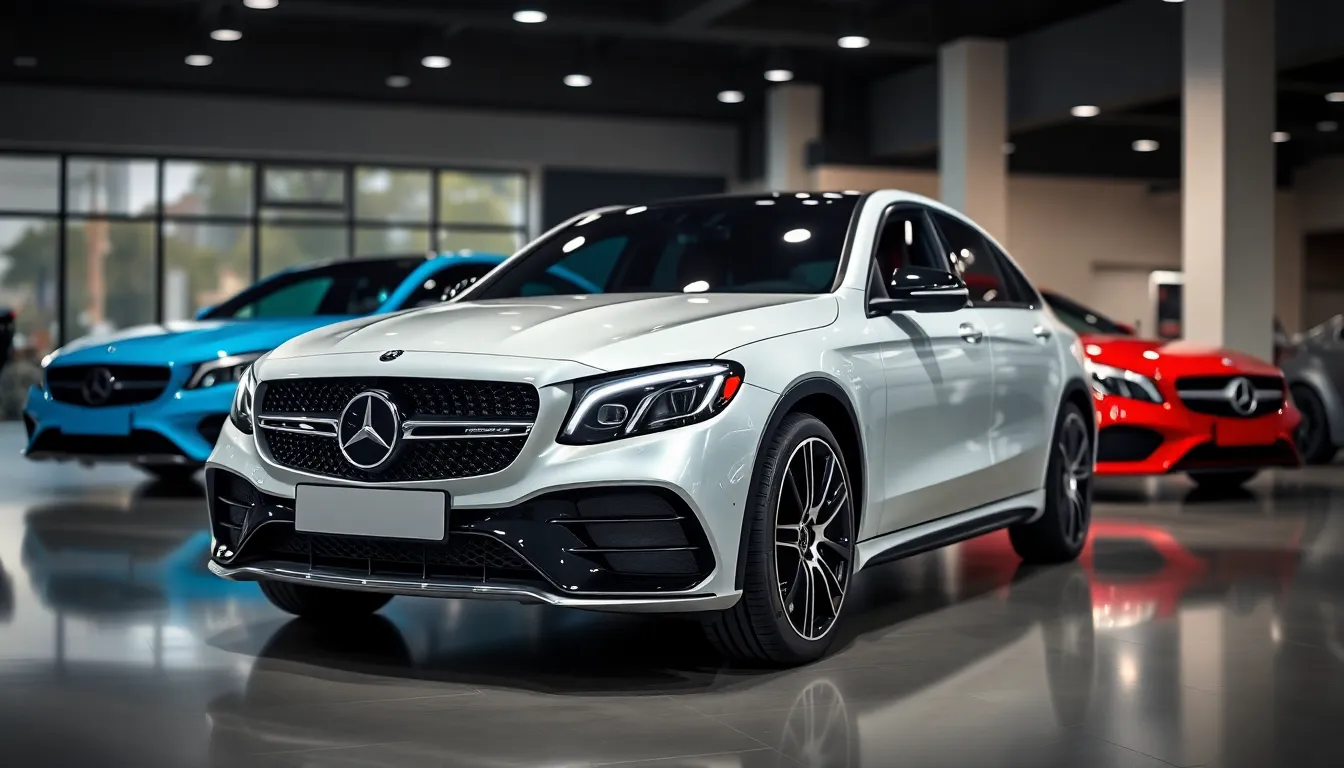
Mercedes-Benz color palettes reflect the brand’s commitment to sophistication while offering extensive customization possibilities. These carefully curated options enhance the distinctive aesthetic identity established through decades of automotive excellence.
Classic Mercedes-Benz Colors
Classic Mercedes-Benz color schemes embody timeless elegance that transcends automotive trends. Obsidian Black Metallic remains the most popular choice among luxury sedan buyers, representing 34% of S-Class deliveries globally according to Mercedes-Benz sales data. This deep metallic finish creates dramatic contrast against chrome accents and enhances the vehicle’s commanding presence on roadways.
Diamond White Metallic serves as the premium alternative, offering pearl-like luminescence that emphasizes clean body lines and sophisticated proportions. The three-layer paint application process includes specialized pearl particles that shift color temperature based on lighting conditions. Iridium Silver Metallic provides the perfect balance between sporty dynamism and executive refinement, featuring microscopic aluminum flakes that create depth and visual interest.
Mercedes-Benz heritage colors like DB 180 Sahara Beige and DB 904 Black connect modern vehicles to the brand’s racing legacy. These historically important options appear on special edition models and commemorate iconic moments in automotive history. Selenite Grey Metallic represents contemporary luxury, incorporating advanced pigment technology that maintains color consistency across different viewing angles.
Modern Paint Technologies and Finishes
Modern Mercedes-Benz paint technologies incorporate cutting-edge innovations that enhance durability and visual impact. MANUFAKTUR customization program offers over 90 exterior color options, including exclusive shades unavailable through standard ordering channels. This premium service allows customers to select unique combinations that reflect personal aesthetic preferences.
Designo finishes feature multi-coat application processes with up to seven individual layers. These specialized treatments include base color, metallic particles, clear protective coating, and UV-resistant topcoat that prevents fading over extended periods. Magno matte finishes create distinctive non-reflective surfaces that require specialized maintenance techniques and cleaning products.
Advanced paint booth technologies ensure consistent application across all vehicle surfaces. Electrostatic spray guns create uniform coverage while robotic application systems eliminate human error variables. Temperature-controlled curing ovens operate at precisely 140°C for optimal paint adhesion and long-term durability.
AMG performance models feature exclusive color options like AMG Green Hell Magno and Designo Cardinal Red Metallic. These high-impact finishes complement aggressive styling elements and performance-oriented design cues. Specialized primer systems enhance paint adhesion on aluminum body panels while maintaining lightweight construction benefits.
Environmental considerations drive development of water-based paint formulations that reduce volatile organic compound emissions. These eco-friendly alternatives maintain color vibrancy and protective qualities while supporting Mercedes-Benz sustainability initiatives across manufacturing operations.
How Mercedes-Benz Aesthetic Influences Luxury Car Design

Mercedes-Benz aesthetic principles serve as the blueprint for contemporary luxury automotive design across the industry. The brand’s distinctive visual language establishes benchmarks that competitors consistently reference when developing their own premium vehicles.
Industry Leadership in Automotive Styling
Mercedes-Benz pioneered the integration of curved surfaces with sharp character lines, a design approach now adopted by manufacturers like BMW, Audi, and Lexus. The brand introduced the concept of “sensual purity” in 2012, emphasizing clean surfaces interrupted by precise details that create emotional connections with viewers. This philosophy transformed how luxury automakers approach surface development and proportion management.
The three-pointed star’s prominence on vehicle fronts established the template for brand-centric grille designs across the premium segment. Competitors responded by enlarging their own emblems and creating signature grille patterns, including BMW’s kidney grilles and Audi’s singleframe designs. Mercedes-Benz’s use of chrome accents around 15% of exterior surfaces became an industry standard for luxury differentiation.
Digital cockpit integration, first showcased in the 2013 S-Class with dual 12.3-inch displays, influenced the entire premium automotive sector’s approach to interior technology. Manufacturers like Genesis, Cadillac, and Jaguar adopted similar horizontal screen layouts and minimalist control strategies following Mercedes-Benz’s pioneering implementation.
Setting Trends Across Premium Segments
Mercedes-Benz’s ambient lighting systems, featuring 64 color options in current models, established interior atmosphere as a luxury differentiator that extends beyond traditional materials and craftsmanship. Premium brands including Volvo, Lincoln, and Infiniti integrated similar lighting technologies to compete in the luxury space.
The brand’s shift toward sustainable luxury materials, incorporating recycled ocean plastics and bio-based leather alternatives, pressured competitors to develop their own eco-conscious interiors. BMW’s introduction of sustainable material options and Audi’s commitment to carbon-neutral production reflect the industry-wide influence of Mercedes-Benz’s environmental initiatives.
Aerodynamic efficiency became a design priority across luxury segments following the EQS’s achievement of a 0.20 coefficient of drag. Manufacturers redesigned their electric vehicle profiles to match Mercedes-Benz’s aerodynamic benchmarks, with models like the BMW iX and Audi e-tron GT adopting similar smooth surface treatments and active aerodynamic elements.
Mercedes-Benz’s MANUFAKTUR customization program, offering over 90 exterior colors and 40 interior trim combinations, established personalization as a luxury expectation. Competitors responded with expanded customization options, including Porsche’s Paint to Sample program and BMW’s Individual collection, recognizing customer desire for unique vehicle specifications influenced by Mercedes-Benz’s comprehensive approach.
Conclusion
Mercedes-Benz’s aesthetic mastery continues to define what luxury automotive design means in today’s market. We’ve witnessed how the brand seamlessly weaves together heritage and innovation creating vehicles that aren’t just transportation but expressions of refined taste and engineering excellence.
The three-pointed star represents more than a logo—it’s become a symbol of automotive artistry that influences entire industry trends. From sustainable materials to cutting-edge technology integration Mercedes-Benz proves that luxury and responsibility can coexist beautifully.
Whether you’re drawn to the S-Class’s opulent elegance the AMG’s aggressive performance aesthetic or the EQS’s futuristic minimalism there’s a Mercedes-Benz design language that speaks to your personal style. This versatility ensures the brand remains relevant across generations while maintaining its unmistakable identity.
Frequently Asked Questions
What makes Mercedes-Benz design aesthetically distinctive?
Mercedes-Benz vehicles command attention through their iconic three-pointed star emblem, flowing body lines, and sophisticated proportions. The brand combines luxury with German engineering excellence, featuring distinctive grille designs, signature C-shaped LED lighting, and purposeful curves that create instantly recognizable silhouettes across all model lines.
How has Mercedes-Benz design evolved over time?
Mercedes-Benz design has evolved from the Classic Era’s timeless elegance with clean geometric lines and chrome accents to the Modern Era’s digital integration and aerodynamic efficiency. This transformation incorporates sustainable materials, advanced manufacturing techniques, and cutting-edge technology while preserving heritage design elements.
What are the key exterior design elements of Mercedes-Benz vehicles?
Key exterior elements include the prominent three-pointed star emblem, distinctive grille designs that vary by model line, sleek body proportions emphasizing luxury and athleticism, and signature lighting features like C-shaped LED daytime running lights and advanced Multibeam LED technology for enhanced brand recognition.
How does Mercedes-Benz approach interior craftsmanship?
Mercedes-Benz transforms interiors into luxury sanctuaries using premium materials like Nappa leather, genuine wood trims, and aluminum accents. The MBUX infotainment system, touch-sensitive controls, ergonomic design, strategically placed ambient lighting, and wireless charging pads create a sophisticated, functional luxury experience.
What distinguishes different Mercedes-Benz model lines aesthetically?
The S-Class epitomizes ultimate luxury with refined proportions and chrome accents. AMG models convey aggressive sportiness through bold design elements. The EQS line features futuristic minimalism with aerodynamic efficiency and sustainable materials. Each model line maintains unique aesthetic philosophies while adhering to core Mercedes-Benz design principles.
What customization options are available for Mercedes-Benz colors?
Mercedes-Benz offers classic colors like Obsidian Black Metallic and Diamond White Metallic for timeless elegance. The MANUFAKTUR program provides over 90 exterior color options with advanced multi-coat paint technologies and eco-friendly formulations. AMG models feature exclusive performance-focused color options.
How does Mercedes-Benz influence luxury automotive design trends?
Mercedes-Benz establishes industry benchmarks through innovations like “sensual purity” design philosophy, curved surfaces with sharp character lines, brand-centric grille templates, digital cockpit integration, ambient lighting systems, sustainable materials usage, and aerodynamic efficiency focus that competitors reference and adopt.

